B User Interface
This section contains information about the user interface for Oracle IRM. The following features are described in this chapter:
B.1 Home Page
Use this page to:
-
Change the accessibility mode to suit screen readers.
-
Access information about Oracle IRM.
-
Access an end-user web site, from which you can download Oracle IRM Desktop software (if downloads have been set up).
-
Access a privacy statement.
-
Access this help.
-
Log in to and log out of the Management Console.
Some options are available only before you are logged in, and other options are available only when you are logged in.
Before you have logged in, open this page by entering the URL of the Management Console home page into a web browser.
After you have logged in, open this page by clicking the Home tab.
| Element | Description |
|---|---|
| Accessibility Mode | This drop-down list is available only before you have logged in.
Use to turn on screen reader mode, making the user interface more suitable for screen readers. Default: Select this option to turn off screen reader mode. Screen Reader: Select this option to turn on screen reader mode. |
| Login | These controls are available only before you have logged in.
Use to log in to the Management Console. Username: Enter a valid user name for Oracle IRM Server. You should have been provided with a user name by an administrator, or you should be using the one set up during installation. Password: Enter the password associated with the previously entered user name. You should have been provided with a password by an administrator, or you should be using the one notified during installation. Login: Select to apply the user name and password entered previously. |
| Oracle IRM Desktop | Use this link to access an end-user web site, from which you can download Oracle IRM Desktop software (if downloads have been set up). |
| About IRM | Use this link to access an Oracle web site containing information about Oracle IRM. |
| Privacy Statement | Use this link to access a privacy statement concerning the collection and use of your personal information, and possibly other matters. |
| Help | This link is available only when you are logged in.
Use to access the online help for Oracle IRM Server. |
| Log Out | This link is available only when you are logged in.
Use to log out of the Management Console. |
B.2 Contexts Page
The following pages and wizards are used to create, set options and enter data for contexts in Oracle IRM:
B.2.1 Contexts Page: General Controls
Use these controls to create and delete contexts, and to refresh the list of contexts.
Access these controls by clicking the Contexts tab.
Contexts Page: General Controls, Left Panel

| Element | Description |
|---|---|
| New Context (icon) | Select to open the New Context wizard. |
| Gain management rights for all orphaned contexts (icon) | Visible only to domain managers and domain administrators. Select to check whether there are any orphaned contexts and, if there are, to acquire the ability to modify them. Orphaned contexts are those whose context manager has been removed from the identity store. Any orphaned contexts will be shown in the list of contexts, and you will be able to select them for modification. |
| Refresh (icon) | Select to refresh the list of contexts on the left panel. You should do this to ensure that the list is showing any changes made by other users. |
| Delete (icon) | Select to delete the context currently highlighted on the left panel. A dialog will ask you to confirm the deletion. You will not be allowed to delete the context if it still has users with assigned rights. |
| Name (contexts list area) | Lists contexts created by the current user. If the current user is an inspector, also lists contexts created by any user. |
Contexts Page: General Controls, Right Panel

| Element | Description |
|---|---|
| Revert | Select to cancel the changes made on this page. Does not work after the Apply button has been used. |
| Apply | Select to apply the changes made on this page. Once selected, the changes cannot be reverted, except by making and applying new changes. |
| Name | Displays the name of the context currently highlighted in the list in the left panel. You can change the name (and the accompanying description) on the Translations tab. |
| Template | This is the name of the template from which this context was created. It cannot be changed. |
| Allow Inspector | When the Allow Inspector checkbox is checked, users who have been made inspectors will be able to see this context in lists and in reports. |
| Collapse Pane/Restore Pane control | Select to hide or show the header display area. |
B.2.2 Contexts Page: Rights
Use this tab to create rights (by assigning roles to a user or group), to view the details of existing rights, to edit rights, and to delete rights.
Access this tab from the Contexts page.

| Element | Description |
|---|---|
| Create Right/Assign Role (icon) | Select to open the Create Right/Assign Role wizard. |
| Properties (icon) | Select to view the details of the right currently highlighted in the Rights table. |
| Edit (icon) | Select to edit the right currently highlighted in the Rights table. |
| Remove (icon) | Select if you want to remove the right currently highlighted in the Rights table. A dialog will ask you to confirm the removal. |
| Search | Enter part or all of the name of the right or rights that you want to display in the Rights table. |
| Search Rights (icon) | Select to search for rights with names matching the text in the search box. If there are more than fifty rights matching the search criteria, only the most recent fifty are shown. You will need to refine the search criteria to see the remaining rights.
If the search box contains no text, selecting this icon will list the fifty most recent rights. |
| Type | This column shows a user icon if the right is for a user. It shows a group icon if the right is for a group. A cross icon means that the type is unknown because the user or group cannot be found in the identity store. |
| Name | This column shows name information for the user or group holding the right. The entry "Not found" means that the name cannot be found in the identity store. |
| Role | This column shows the role that was assigned to the user or group to create the right. |
| Assigned Time | This column shows the date and time that the right was created. The list of rights is initially ordered by date and time. |
B.2.3 Contexts Page: Translations
Use this tab to:
-
Add names and descriptions of the current context in alternative languages (that is, alternative to the default language).
-
Edit existing names and descriptions.
-
Delete alternative names and descriptions that are no longer required.
Access this tab from the Contexts page.

| Element | Description |
|---|---|
| New Translation (icon) | Select to open the New Translation dialog, through which names and descriptions can be added for alternative languages.
This is available only if multiple language support has been set up on the Control Console. |
| Edit (icon) | Select to edit the language details currently highlighted in the Translations table. |
| Remove (icon) | Select to remove the language details currently highlighted in the Translations table. A dialog will ask you to confirm the removal. You cannot remove the default language details. |
| Language | This column identifies the languages for which names and descriptions have been provided. |
| Default language (indicator)
|
This indicator against a language name shows that it is the default language. The default language is set on the Control Console. This is the language that is used in locales for which no alternative has been provided. You cannot remove this language from the Translations table. |
| Name | For each language, this column shows the name provided. |
| Description | For each language, this column shows the description provided. |
B.2.4 Contexts Page: Managers
Use this tab to assign users as managers of the current context (creates context managers). Also use to view context manager details, and to end a user being the manager of a context.
Access this tab from the Contexts page.

| Element | Description |
|---|---|
| New Manager (icon) | Select to open the New Manager dialog. |
| Properties (icon) | Select to view the details of the user currently highlighted in the Managers table. |
| Remove (icon) | Select to end the user selected in the Managers table being a manager of the current context. A dialog will ask you to confirm the removal. |
| Account Name, First Name, Last Name | These columns identify the users that have been assigned as managers of the current context. |
B.2.5 Contexts Page: Exclusions
Use this tab to exclude specific sealed documents from the current context. Also use to end such exclusions.
Access this tab from the Contexts page.
| Element | Description |
|---|---|
| Add Documents | Select this button to open a dialog through which you can find a sealed file that you want to exclude. |
| Remove (icon) | Select if you want to end the exclusion of the file currently highlighted in the table. A dialog will ask you to confirm the removal. |
| Document and Sealed Time | These columns show information for the sealed documents that have been excluded from the current context. |
B.2.6 Contexts Page: Trusted Contexts
Use this tab to manage the trusted contexts for the current context. Trusted contexts are contexts to which sealed content can be exported from the current context.
Access this tab from the Contexts page.

| Element | Description |
|---|---|
| New Trusted Context (icon) | Select to open the New Trusted Context dialog. |
| Remove (icon) | Select to end the trusted context status of the context currently selected in the Trusted Contexts table. A dialog will ask you to confirm the removal. |
| Name | This column shows the names of trusted contexts for the current context. |
| Description | This column shows the descriptions of trusted contexts for the current context. |
B.2.7 New Trusted Context Dialog
Use this dialog to associate the current context with other existing contexts. This will establish the latter as trusted contexts, which are contexts to which sealed content can be exported.
Open the dialog by clicking the New Trusted Context icon on the Trusted Contexts tab of the Contexts page.
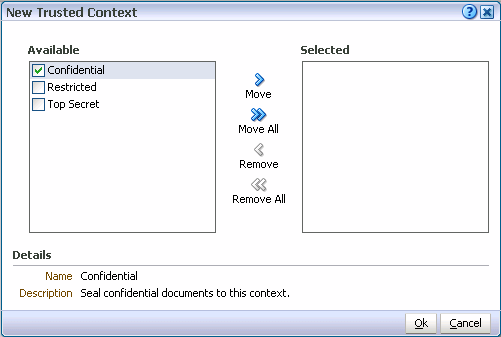
| Element | Description |
|---|---|
| Available | This box shows contexts that can be assigned as trusted contexts for the current context. Highlight the contexts in this box that you want to move to the Selected box. |
| Move, Move All, Remove, Remove All | Use these controls to move context names between the Available and Selected boxes. The Move control and the Remove control will become available only when individual contexts are selected and will affect only those contexts. |
| Selected | All contexts whose names are listed in this box will become trusted contexts when the OK button is clicked. The presence or absence of check marks does not have any effect on this. |
| Details | This display area shows the details of any context individually selected in the Available or Selected boxes. |
B.2.8 New Context Wizard
Use this wizard to create a new context, based on an existing context template. Domain administrators can create context templates. Domain administrators and domain managers can create contexts.
Open the wizard by clicking the New Context icon on the left panel of the Contexts page.
B.2.8.1 New Context: Settings
Use this page to name and describe a new context.
This page opens by default as the first page of the New Context wizard. It can also be opened by selecting the Settings node in the wizard header.
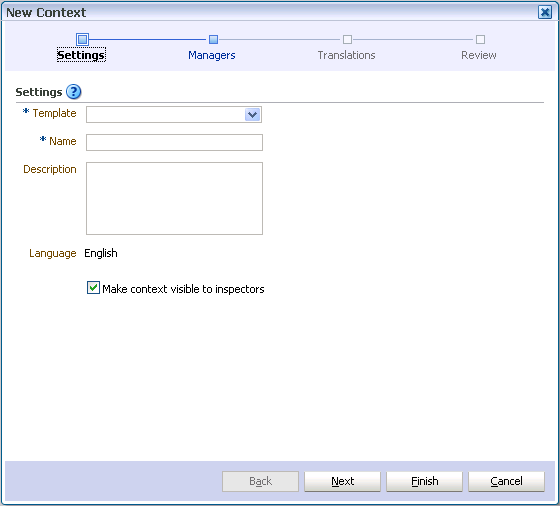
| Element | Description |
|---|---|
| Template | Choose one of the available context templates from this drop-down list. Only active context templates are shown. You must base the new context on one of the available context templates. (Context templates can be created by domain administrators using the Context Templates page.) |
| Name
Description |
Enter a name and description for the new context.
The name will be seen by users of Oracle IRM Desktop when they seal documents to this context, so the name should reflect the purpose of the context. You should enter the name and description in the default language. The default language is shown against Language on this wizard page. The default language was set up on the Control Console, and is the language that is used in locales for which no specific translation has been provided. You will be able to provide names and descriptions in other languages on the Translations page of this wizard, if multiple language support has been set up on the Control Console. |
| Language | Shows which language has been set on the Control Console as the default language. |
| Make Context Visible To Inspectors | This is normally checked. Contexts should be made visible to inspectors. Domain administrators that are also inspectors (as is recommended) will then be able to see all contexts that have been created, and be able to judge the effects of changing a context template.
You should only consider making the context not visible to inspectors if the context relates to highly sensitive matters. If you make a context not visible to inspectors, there is a danger that alterations to the context template on which it is based will have unintended consequences. |
B.2.8.2 New Context: Managers
Use this page to assign one or more users to the context, making them context managers of this context. Context managers assign roles to users and are usually business owners.
You do not have to add yourself as a context manager: the user creating the context is automatically made a context manager.
This page opens as the second page of the New Context wizard. It can also be opened by selecting the Managers node in the wizard header.
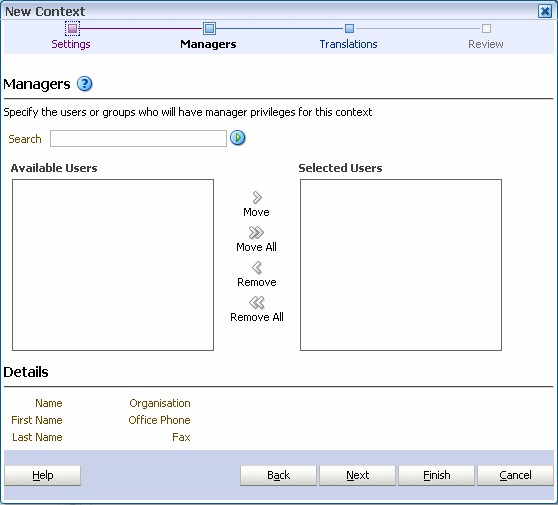
| Element | Description |
|---|---|
| Search
Search Users (icon) |
Use this box and icon to populate the Available box with users who are candidates to become context managers. To find known users, type a few letters from the user name into the Search box, then click the Search button. To find all users, leave the Search box empty, then click the Search button. |
| Available Users | This box shows users that can be assigned as context managers. If the list is empty, populate it using the Search feature (described above). Highlight the users in this box that you want to move to the Selected Users box. |
| Move, Move All, Remove, Remove All | Use these controls to move user names between the Available Users and the Selected Users boxes. The Move control and the Remove control will affect only those users that have a check mark against them. |
| Selected Users | Users whose names are listed in this box will become context managers for this context when the wizard is completed.
The presence or absence of check marks does not have any effect on this. The user who created the context will become a context manager even if his name is not listed in this box. |
| Details | This display area shows the details of any user individually selected in the Available Users or Selected Users boxes. |
B.2.8.3 New Context: Translations
Use this page to provide names and descriptions of the new context in alternative languages (that is, alternative to the default language).
The name and description that you entered for the default language will already be shown on this page.
This page opens as the third page of the New Context wizard. It can also be opened by selecting the Translations node in the wizard header.
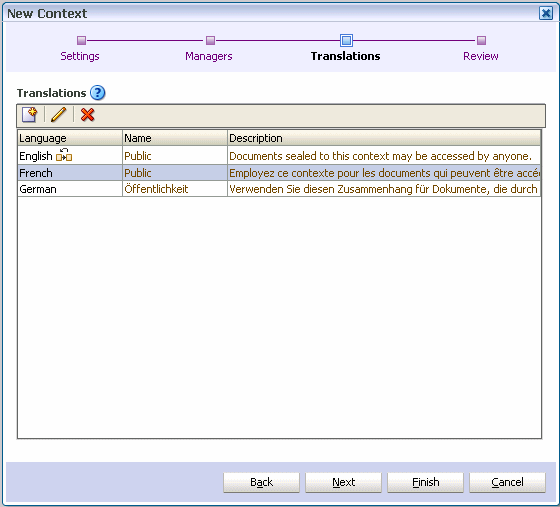
| Element | Description |
|---|---|
| New Translation (icon) | Select to open the New Translation dialog, through which names and descriptions can be added for alternative languages.
This is available only if multiple language support has been set up on the Control Console. |
| Edit (icon) | Select to edit the language details currently highlighted in the Translations table. You cannot change the language associated with an existing name or description. |
| Remove (icon) | Select to remove the language details currently highlighted in the Translations table. A dialog will ask you to confirm the removal. You cannot remove the default language details. |
| Language | This column identifies the languages for which names and descriptions have been provided. |
| Default language (indicator)
|
This indicator against a language name shows that it is the default language. The default language is set on the Control Console. This is the language that is used in locales for which no alternative has been provided. You cannot remove this language from the Translations table. |
| Name | For each language, this column shows the name provided. |
| Description | For each language, this column shows the description provided. |
B.2.8.4 New Context: Review
Use this page to review the choices made and information entered on the previous wizard pages.
This page opens as the final page of the New Context wizard. It can also be opened by selecting the Review node in the wizard header.
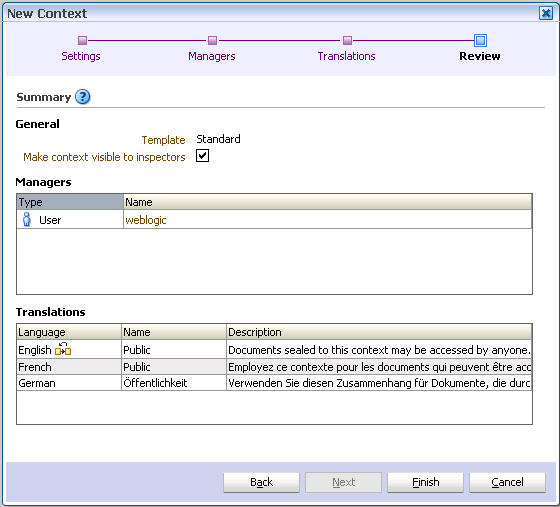
If you are not satisfied with the choices and entries shown on the Review page, use the Back button to return to the wizard pages and make changes.
If you are satisfied with the choices and entries shown on the Review page, create the new context by clicking the Finish button.
B.2.9 Assign Role (Create Right) Wizard
Use this wizard to create a new right (that is, assign a role to one or more users or groups). Rights are created by context managers.
Open the wizard by clicking the Assign Role icon in the toolbar of the Rights tab on the Contexts page.
B.2.9.1 Assign Role: Users and Groups
Use this page to specify one or more users or groups that will be granted the new right.
This page opens as the first page of the Assign Role wizard. It can also be opened by selecting the Users/Groups node in the wizard header.
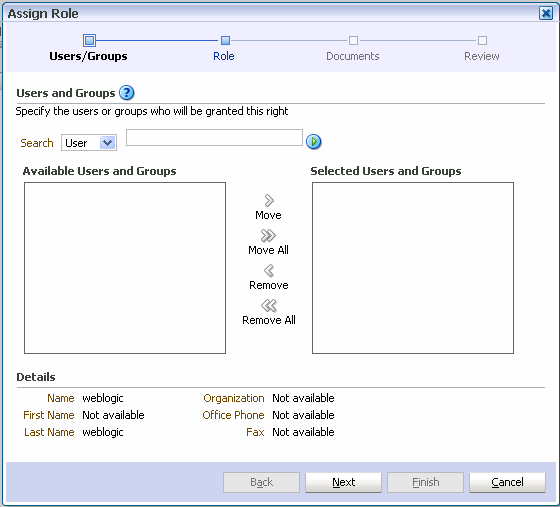
| Element | Description |
|---|---|
| Search
Search Users (icon) |
Use this drop-down list, text box, and icon to populate the Available Users box with users or groups that are candidates to acquire the new right. First select either User or Group from the drop-down list. To find known users/groups, type a few letters from the name into the Search box, then click the Search Users icon. To find all users/groups, leave the Search box empty, then click the Search Users icon. Only users or groups that have not already been assigned a role in this context will be shown. This is because a user or group can have only one directly assigned role per context. |
| Available Users and Groups | This box shows users or groups that can be assigned a role. If the list is empty, populate it using the Search feature (described above). Highlight the users in this box that you want to move to the Selected Users and Groups box. |
| Move, Move All, Remove, Remove All | Use these controls to move user or group names between the Available... and Selected... boxes. The Move control and the Remove control will become available only when individual users or groups have a check mark against them, and will affect only those users and groups. |
| Selected Users and Groups | Users or groups whose names are listed in this box will be assigned a role (specified on the next page of this wizard) for this context when the wizard is completed.
The presence or absence of check marks does not have any effect on this. |
| Details | This display area shows the details of any user or group individually selected in the Available... or Selected... boxes. |
B.2.9.2 Assign Role: Role
Use this page to specify which role is to be assigned in the creation of the right.
This page opens by default as the second page of the Assign Role wizard. It can also be opened by selecting the Role node in the wizard header.
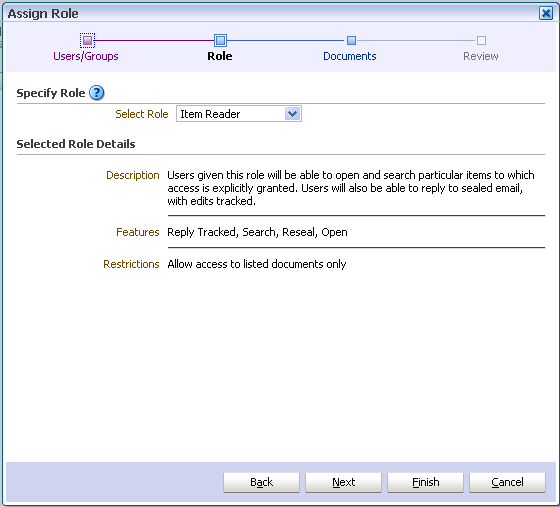
| Element | Description |
|---|---|
| Specify Role | Select Role: Use to select a role for the new right. Roles cannot be created here: they are created by domain administrators using the Roles page. |
| Selected Role Details | Description: Displays the description of the role. The description was written when the role was created.
Features: Displays the sealing features that are associated with the role. These features are part of the role definition and cannot be altered here. ("Features" in Oracle IRM Server equate to "Rights" in Oracle IRM Desktop.) Restrictions: Displays the type of document access that was set up when the role was created. The listed documents referred to here are specified on the next page of this wizard, the Documents page. |
B.2.9.3 Assign Role: Documents
Use this page to list specific sealed documents that users assigned this role can access, or specific sealed documents that users assigned this role cannot access.
This page opens by default as the third page of the Assign Role wizard. It can also be opened by selecting the Documents node in the wizard header.
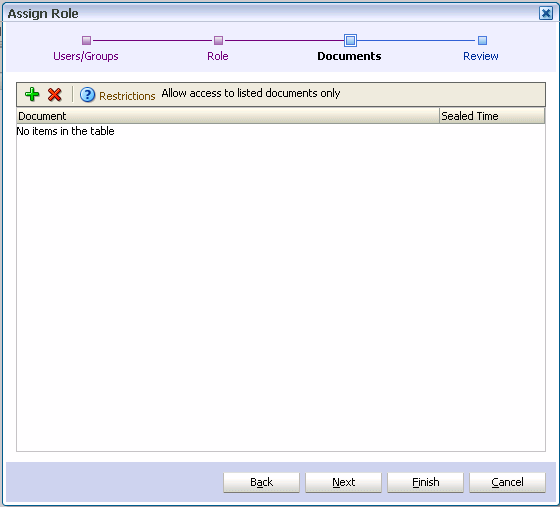
| Element | Description |
|---|---|
| Add (icon) | Select to open a dialog through which you can add a sealed document to the list. Only sealed documents in supported formats can be added: if you attempt to add a document type that is unsealed or not of a supported format, you will see an error message. |
| Delete (icon) | Select to remove the currently highlighted document from the list. |
| Restrictions (display) | Disallow access to listed documents: This means that the user assigned this role will be able to access all sealed documents (subject to context), except any that are listed in the table on this page.
Allow access to listed documents only: This means that the user assigned this role will not be able to access any sealed documents, except the ones listed in the table on this page. If you do not add sealed documents to this table, either now or by editing this role assignment later, the user will not be able to access any documents. |
| Document (column) | Lists the sealed documents associated with this role assignment. |
| Sealed time (column) | For each sealed document listed, shows the time that it was sealed. |
B.2.9.4 Assign Role: Summary
Use this page to review the choices made and information entered on the previous wizard pages.
This page opens as the final page of the Assign Role wizard. It can also be opened by selecting the Review node in the wizard header.

If you are not satisfied with the choices and entries shown on the Summary page, use the Back button to return to the wizard pages and make changes.
If you are satisfied with the choices and entries shown on the Summary page, create the new right by clicking the Finish button.
B.2.10 Right Details Dialog
This dialog displays information about the user (or group), and the assigned role, for the right currently highlighted in the Rights table.
Open the dialog by clicking the Properties icon in the toolbar of the Rights tab on the Contexts page.
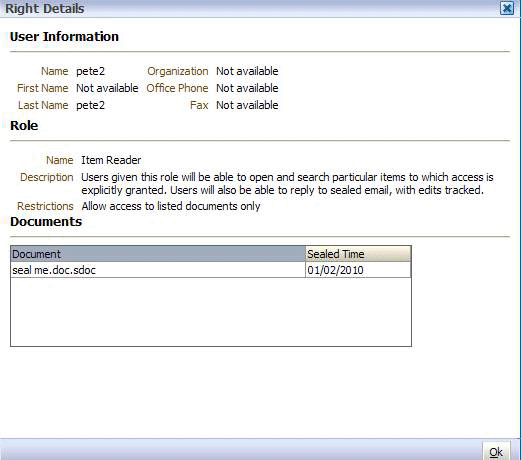
B.2.11 Edit Role Assignment Dialog
Use this dialog to edit a right (that is, change the assignment of a role to a user or group).
Open the dialog by clicking the Edit icon in the toolbar of the Rights tab on the Contexts page.
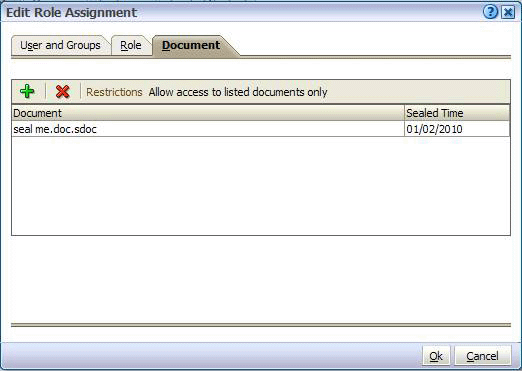
Edit Role Assignment: Users and Groups
This tab displays the users or groups that are currently granted the right.
Access this tab from the Edit Role Assignment dialog.
Use this tab to change the assigned role for this right.
Access this tab from the Edit Role Assignment dialog.
| Element | Description |
|---|---|
| Assigned Role | Use this drop-down list to select a new role for the right. Roles cannot be created here: they are created by domain administrators using the Roles page. For multiple users and groups, if they all have the same role, the drop-down list shows the current role. |
| Role Description | Displays the description of the role. The description was written when the role was created. |
Edit Role Assignment: Documents
Access this tab from the Edit Role Assignment dialog.
This tab displays the specific set of sealed documents associated with the right, if any. You can add documents to the table on this tab using the Add icon. You can remove documents from the table using the Delete icon.
If the Restrictions display area shows Allow access to listed documents only, the table should list the only sealed documents that can be accessed by users assigned this role. In this case, if no documents are listed, users assigned this role cannot access any sealed documents.
If the Restrictions display area shows Disallow access to listed documents, the table may list sealed documents that cannot be accessed by users assigned this role. In this case, if no documents are listed, users assigned this role can access any sealed document (subject to context).
B.2.12 New Manager Dialog
Use this dialog to assign a user as the manager of a context, making that user a context manager.
Open the dialog by clicking the New Manager icon in the toolbar of the Managers tab of the Contexts page.

| Element | Description |
|---|---|
| Search
Search Users (icon) |
Use this text box and icon to populate the Available Users box with users that are candidates to become managers. To find known users, type a few letters from the user name into the Search box, then click the Search Users icon. To find all users, leave the Search box empty, then click the Search Users icon. |
| Available Users | This box shows users that can be assigned as managers. If the list is empty, populate it using the Search feature (described above). Highlight the users in this box that you want to move to the Selected Users box. |
| Move, Move All, Remove, Remove All | Use these controls to move user names between the Available Users and Selected Users boxes. The Move control and the Remove control will become available only when individual users have a check mark against them, and will affect only those users. |
| Selected Users | Users whose names are listed in this box will become managers when the OK button is clicked.
The presence or absence of check marks does not have any effect on this. |
| Details | This display area shows the details of any user individually selected in the Available Users or Selected Users boxes. |
B.2.13 Manager Details Dialog
This dialog displays information about the manager (that is, the user assigned as a context manager for the current context) currently highlighted in the Managers table.
Open the dialog by clicking the View Details/Properties icon on the toolbar of the Managers tab on the Contexts page.

B.3 Roles Page
The following pages and wizards are used to create, modify, set options and enter data for roles in Oracle IRM:
B.3.1 Roles Page: General Controls
Use these controls to create, copy, and delete roles, and to refresh the list of roles. Roles are created by domain administrators.
Access these controls from the Roles tab.

| Element | Description |
|---|---|
| New Role (icon) | Select to open the New Role wizard. |
| Copy (icon) | Immediately creates a copy of the role currently highlighted in the list of roles in the left panel. |
| Refresh (icon) | Select to refresh the list of roles in the left panel. You should do this to ensure that the list is showing roles that may have been created or deleted by other users. |
| Delete (icon) | Select if you want to delete the role currently highlighted in the left panel. A dialog will ask you to confirm the deletion. |
| Name | Lists all existing roles. Three standard roles are included at the time of installation. These can be used as supplied, modified before use, or deleted if not required.
Contributor with export: This role will not significantly restrict the use of sealed documents. Users given this role will be able to create, open, search, edit, and print all documents. Users will also be able to copy information to contexts on this server that have been set up as trusted contexts, and in which they have edit rights. Very importantly, users given this role will be able to create unsealed versions of documents. Reader with export: This role will not allow creation of sealed documents, but it will not significantly restrict what users can do to sealed documents that they are given access to. Users given this role will be able to open, search, and print all documents. They will also be able to reply to sealed email, with edits tracked. Very importantly, users given this role will be able to create unsealed versions of documents. Reader without print: This role will give significant protection to sealed documents. Users given this role will be able to open and search all documents. They will also be able to reply to sealed email, with edits tracked. |

| Element | Description |
|---|---|
| Revert | Select to cancel the changes made on this page. Does not work after the Apply button has been used. |
| Apply | Select to apply the changes made on this page. Once selected, the changes cannot be reverted, except by making and applying new changes. |
| Name (display) | Displays the name of the role currently highlighted in the list in the left panel. You can change the name on the Translations tab. |
| Description (display) | Displays the description of the role currently highlighted in the list in the left panel. You can change the description on the Translations tab. |
| Collapse Pane/Restore Pane control | Select to hide or show the header display area. |
B.3.2 Roles Page: Features
Use this tab to assign and remove sealing features for the role.
For a role to be valid, at least one of the following features must be assigned: open, seal, reseal, search, copy to, save unsealed.
Access this tab from the Roles page.
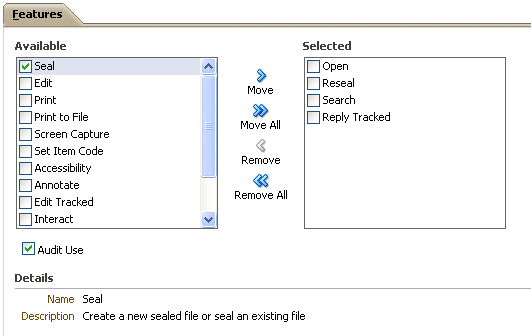
| Element | Description |
|---|---|
| Audit Use | Check this box if you want the use of this role to be recorded. |
| Available | This box lists all sealing features that are not currently assigned to the role. Highlight the sealing features in this box that you want to move to the Selected box. |
| Move, Move All, Remove, Remove All | Use these controls to move sealing features between the Available and Selected boxes. The Move control and the Remove control will become available only when individual features have a check mark against them, and will affect only those features. |
| Selected | This box lists the sealing features that are currently assigned to the role, or that will be once they are applied (by clicking the Apply button).
The presence or absence of check marks does not have any effect on this. |
| Details | This display area shows the details of any feature individually selected in the Available or Selected boxes. |
B.3.3 Roles Page: Translations
Use this page to:
-
Add names and descriptions of the current role in alternative languages (that is, alternative to the default language).
-
Edit existing names and descriptions.
-
Delete alternative names and descriptions that are no longer required.
Access this tab from the Roles page.

| Element | Description |
|---|---|
| New Translation (icon) | Select to open the New Translation dialog, through which names and descriptions can be added for alternative languages.
This is available only if multiple language support has been set up on the Control Console. |
| Edit (icon) | Select to edit the language details currently highlighted in the Translations table. |
| Remove (icon) | Select to remove the language details currently highlighted in the Translations table. A dialog will ask you to confirm the removal. You cannot remove the default language details. |
| Language | This column identifies the language for which the alternative name and description have been provided. |
| Default language (indicator)
|
This indicator against a language name shows that it is the default language. The default language is set on the Control Console. This is the language that is used in locales for which no alternative has been provided. You cannot remove this language from the Translations table. |
| Name | For each language, this column shows the name provided. |
| Description | For each language, this column shows the description provided. |
B.3.4 Roles Page: Constraints
Use this tab to specify time and other constraints for the role.
Access this tab from the Roles page.
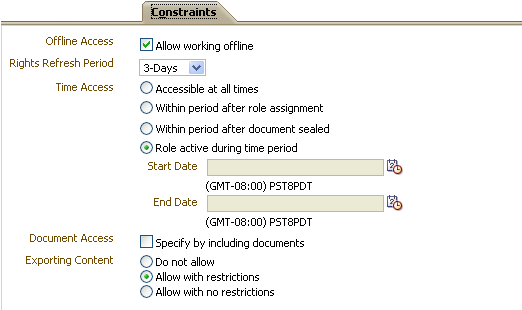
| Element | Description |
|---|---|
| Offline Access | Allow working offline Check this box to allow users to work on sealed documents even when they have no connection to the server (Oracle IRM Server). The maximum length of time that the user can work offline is the same as the rights refresh period (see below). |
| Rights Refresh Period | Use this drop-down list to select the maximum length of time that users can use rights before they are refreshed from the server. When the rights are refreshed, any new permissions or restrictions are applied.
The periods available here are set up on the Control Console. Unless they have been changed from the defaults, the periods that you can choose from are 10 days, 3 days, 24 hours, 3 hours, and 10 minutes. Short refresh periods will generate more traffic between client and server than long refresh periods, which may be a consideration if bandwidth is restricted. |
| Time Access | You can permit access to the sealed content covered by this role at all times, or during specific periods. The default is for sealed content to be accessible at all times (to those with the right to access it). Select from the following:
Accessible at all times Select this option if you want access to sealed content without time constraints. Within period after role assignment Select this option if you want access restricted to a specific period after the role has been assigned to a user (that is, when a right has been created). You can choose a number of seconds, minutes, hours, days, months, or years using the controls that will appear when you select this option. Within period after document sealed Select this option if you want access restricted to a specific period after a document has been sealed. You can choose a number of seconds, minutes, hours, days, months, or years using the controls that will appear when you select this option. Role active during time period Select this option if you want to allow access to sealed content between two calendar dates. Controls will appear when you select this option: enter the start and end dates directly, or use the calendar controls to select the dates. |
| Document Access | When creating and managing rights, it is possible to apply those rights to specific documents within a context, rather than to all documents within a context.
Specify by including documents Check this box to require the listing of documents to which rights do apply. |
| Exporting Content | Use these options to allow or disallow export of content (by copying through the clipbboard or by saving a sealed file as an unsealed file). The default is to not allow export of content from sealed documents.
Do not allow Choose this option if you want no export of content from sealed documents accessed by this role. Allow with restrictions Choose this option if you want to allow export of content to trusted contexts. See Section B.2.6, "Contexts Page: Trusted Contexts". Allow with no restrictions Choose this option only if you want to allow export of content from sealed documents accessed by this role. This effectively allows a user assigned this role to remove protection from sealed documents. This option should be chosen only after careful consideration of the consequences. |
B.3.5 New Role Wizard
Use this wizard to create a new role. Roles are created by domain administrators.
Open the wizard by clicking the New Role icon in the left panel of the Roles page.
B.3.5.1 New Role: General
Use this page to name and describe a new role.
This page opens by default as the first page of the New Role wizard. It can also be opened by selecting the General node in the wizard header.
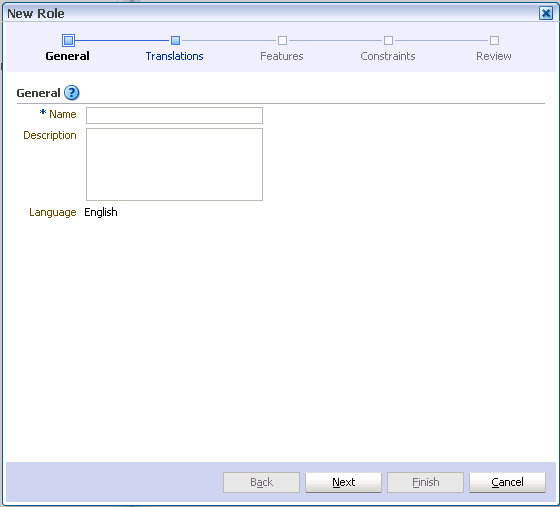
| Element | Description |
|---|---|
| Name
Description |
Enter a name and description for the new role.
The description will be viewable, for example, when creating other Oracle IRM components that are dependent on this one, so a brief but informative description will prove useful. You should enter the name and description in the default language, as shown against Language on this wizard page. The default language was set up on the Control Console, and is the language that is used in locales for which no specific translation has been provided. You will be able to provide names and descriptions in other languages on the Translations page of this wizard, if multiple language support has been set up on the Control Console. |
| Language | Shows which language has been set on the Control Console as the default language. |
B.3.5.2 New Role: Translations
Use this page to provide names and descriptions of the new role in alternative languages (that is, alternative to the default language).
The name and description that you entered for the default language will already be shown on this page.
This page opens as the second page of the New Role wizard. It can also be opened by selecting the Translations node in the wizard header.
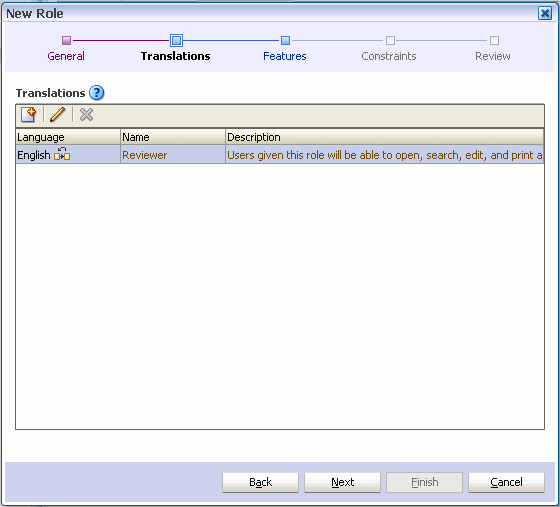
| Element | Description |
|---|---|
| New Translation (icon) | Select to open the New Translation dialog, through which names and descriptions can be added for alternative languages.
This is available only if multiple language support has been set up on the Control Console. |
| Edit (icon) | Select to edit the language details currently highlighted in the Translations table. You cannot change the language associated with an existing name or description. |
| Remove (icon) | Select to remove the language details currently highlighted in the Translations table. A dialog will ask you to confirm the removal. You cannot remove the default language details. |
| Language | This column identifies the languages for which names and descriptions have been provided. |
| Default language (indicator)
|
This indicator against a language name shows that it is the default language. The default language is set on the Control Console. This is the language that is used in locales for which no alternative has been provided. You cannot remove this language from the Translations table. |
| Name | For each language, this column shows the name provided. |
| Description | For each language, this column shows the description provided. |
B.3.5.3 New Role: Features
Use this page to assign and remove sealing features for the role. Features control the ability of users to create and use sealed documents. These features equate to "rights" in Oracle IRM Desktop.
For a role to be valid, at least one of the following features must be assigned: open, seal, reseal, search.
This page opens as the third page of the New Role wizard. It can also be opened by selecting the Features node in the wizard header.
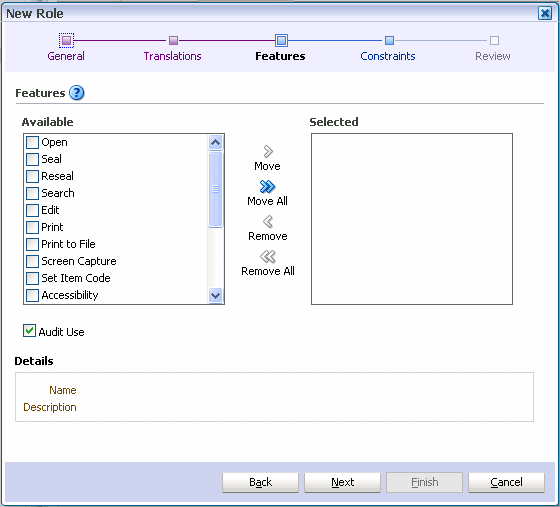
| Element | Description |
|---|---|
| Available | This box lists all sealing features that are not currently assigned to the role. Select each one to see its description in the Details area. Highlight the features in this box that you want to move to the Selected box. |
| Move, Move All, Remove, Remove All | Use these controls to move features between the Available and Selected boxes. The Move control and the Remove control will become available only when individual features have a check mark against them, and will affect only those features. |
| Selected | Sealing features listed in this box will be applied to the role when the wizard is completed. The presence or absence of check marks does not have any effect on this. |
| Audit Use | Check this box if you want to the use of this role to be recorded. |
| Details | This display area shows the details of any feature individually selected in the Available or Selected boxes. |
B.3.5.4 New Role: Constraints
Use this page to specify time and other constraints for the role.
This page opens as the fourth page of the New Role wizard. It can also be opened by selecting the Constraints node in the wizard header.
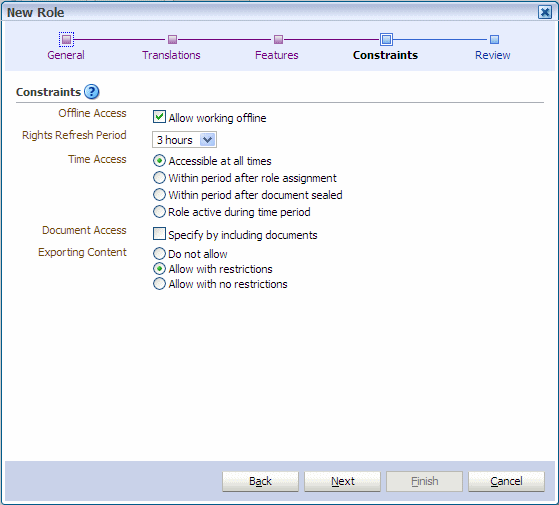
| Element | Description |
|---|---|
| Offline Access | Allow working offline: Check this box to allow users to work on sealed documents even when they have no connection to the server (Oracle IRM Server). The maximum length of time that the user can work offline is the same as the rights refresh period (see below). |
| Rights Refresh Period | Use this drop-down list to select the maximum length of time that users can use rights before they are refreshed from the server. When the rights are refreshed, any new permissions or restrictions are applied.
The periods available here are set up on the Control Console. Unless they have been changed from the defaults, the periods that you can choose from are 10 days, 3 days, 1 day, and 3 hours. Short refresh periods will generate more traffic between client and server than long refresh periods, which may be a consideration if bandwidth is restricted. |
| Time Access | You can permit access to the sealed content covered by this role at all times, or during specific periods. The default is for sealed content to be accessible at all times (to those with the right to access it). Select from the following:
Accessible at all times: Select this option if you want access to sealed content without time constraints. Within period after role assignment: Select this option if you want access restricted to a specific period after the role has been assigned to a user (that is, when a right has been created). You can choose a number of seconds, minutes, hours, days, months, or years using the controls that appear when you select this option. Within period after document sealed: Select this option if you want access restricted to a specific period after a document has been sealed. You can choose a number of seconds, minutes, hours, days, months, or years using the controls that appear when you select this option. Role active during time period: Select this option if you want to allow access to sealed content between two calendar dates. Controls will appear when you select this option: enter the start and end dates directly, or use the calendar controls to select the dates. |
| Document Access | When creating and managing rights, it is possible to apply those rights to specific documents within a context, rather than to all documents within a context.
Specify by including documents: Check this box to require the listing of documents to which rights do apply. |
| Exporting Content | Some sealing features control the exporting of content from a sealed document. Such export behavior can be permitted or denied on a feature-by-feature basis, or you can use these Exporting Content options to allow or disallow export of content on a broad basis. The default is to not allow export of content from sealed documents.
Do not allow: Select this option if you want no export of content from sealed documents accessed by this role. Allow with restrictions: Select this option if you want to allow export of content to trusted contexts. See Section B.2.6, "Contexts Page: Trusted Contexts". Allow with no restrictions: Select this option if you want to allow export of content from sealed documents accessed by this role. |
B.3.5.5 New Role: Summary
Use this page to review the choices made and information entered on the previous wizard pages.
This page opens as the final page of the wizard. It can also be opened by selecting the Review node in the wizard header.
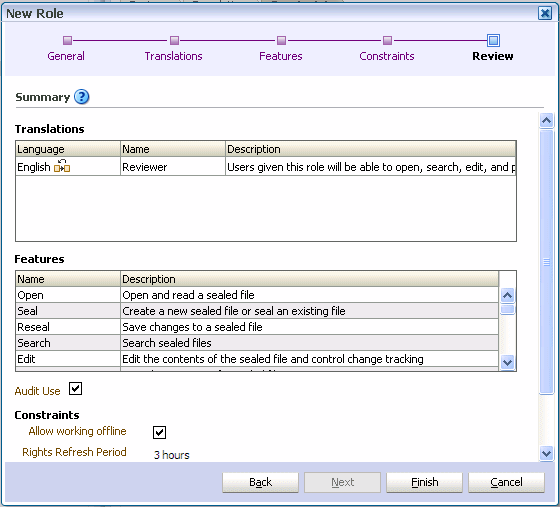
If you are not satisfied with the choices and entries shown on the Summary page, use the Back button to return to the wizard pages and make changes.
If you are satisfied with the choices and entries shown on the Summary page, create the new role by clicking the Finish button.
B.4 Reports Page
Use this page to generate and view reports about the use of Oracle IRM.
Open by clicking the Reports tab.
Use this panel to generate reports. Only context managers and inspectors can generate reports. Inspectors are limited to generating reports for contexts that have been made visible to them.
Access this panel from the Reports tab.

| Element | Description |
|---|---|
| Generate Report | After you have specified search criteria using the other controls on this page, click this button to generate the report. |
| Reset | Select to remove the search criteria on this page. |
| User Name
Search (icon) |
Use this text box and icon to include records for one or more users.
User Name: Enter a user name, or a part of one or more user names. Search: Click this button to open the Search Users dialog, through which you can search for and select specific users whose records you want to include in the report. |
| Document Name | Use this text box to include records for one document.
Enter the document's name in the Document Name box. |
| Documents To Include | Use these controls to include records for more than one document.
Add Documents (icon): Select to open the Add Document dialog, through which you can browse to a document that you want included in the report. Repeat to add further documents. Document Name: Lists the documents that will be reported on. Delete Document (icon): Select this icon to remove the document currently highlighted in the Document Name list. |
| Time | Use these controls to search for features used during a specific time period.
Start Date and End Date: Enter the start date and end date of the period. You can type the dates in directly, or you can select the Select Date And Time icons to open calendars from which you can select the dates. |
Use this panel to view the results of report generation.
Access this panel from the Reports tab.

| Element | Description |
|---|---|
| Time | The date and time at which the feature was used. |
| User | The account name of the user who used or attempted to use the feature. |
| Feature | The Oracle IRM feature that was used or that an attempt was made to use.
These features correspond to Oracle IRM Desktop "rights". |
| Context | The context in which the feature was used. |
| Item Code | The identifier of the document for which the feature was used. |
| Location | The document for which the feature was used, in its location. |
| Device Name | The name of the device hosting the document for which the feature was used. |
| Status | Whether the attempt to use the feature was successful (SUCCESS) or whether it failed (FAILURE). |
B.5 Context Templates Page
The following pages and wizards can be used by domain administrators to create, set options, and enter data for context templates in Oracle IRM:
B.5.1 Context Templates Page: General Controls
Use these controls to create, copy, and delete context templates, and to refresh the list of context templates.
Access the controls from the Context Templates page.
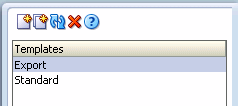
| Element | Description |
|---|---|
| New Context Template (icon) | Select to open the New Context Template wizard. |
| Copy (icon) | Select to immediately copy the template currently highlighted in the Templates list in the left panel. The copy is given the same name as the original, but with "Copy of" added to the beginning. The copy is added to the Templates list. You can change the name and the accompanying description on the Translations tab in the right panel. |
| Refresh (icon) | Select to refresh the list of templates in the left panel. You should do this to ensure that the list is showing any changes made by other users. |
| Delete (icon) | Select if you want to delete the template currently highlighted in the left panel. A dialog will ask you to confirm the deletion. |
| Templates | This list shows all context templates that currently exist for this domain. Two context templates are supplied at installation: "Export", and "Standard". These can be copied to create new context templates, and then modified as required.
Standard: As supplied, this context template contains roles that would typically be assigned to users or groups that are not entitled to create unsealed versions of sealed documents. This context template is supplied active, in which state it will be available for domain managers to create contexts from. Export: As supplied, this context template contains roles that would typically be assigned to users or groups entitled to create unsealed versions of sealed documents. This context template is supplied inactive, in which state it is not available to create contexts from. The roles included in the templates are listed in the Selected box on the Roles tab. To see how a particular role has been defined, click it in the Selected box: its description and all its other attributes are shown in the tabbed Details area at the foot of the page. |

| Element | Description |
|---|---|
| Revert | Select to cancel the changes made on this page. Does not work after the Apply button has been used. |
| Apply | Select to apply the changes made on this page. Once selected, the changes cannot be reverted, except by making and applying new changes. |
| Name (display) | Displays the name of the context template currently highlighted in the list in the left panel. You can change the name on the Translations tab. |
| Description (display) | Displays the description of the context template currently highlighted in the list in the left panel. You can change the description on the Translations tab. |
| Template Is Active | If this box is checked, the template will be available to domain managers, who will be able to create contexts based on it. |
| Collapse Pane/Restore Pane control | Select to hide or show the header display area. |
B.5.2 Context Templates Page: Roles
Use this tab to add roles to and remove roles from the context template.
Access this tab from the Context Templates page.
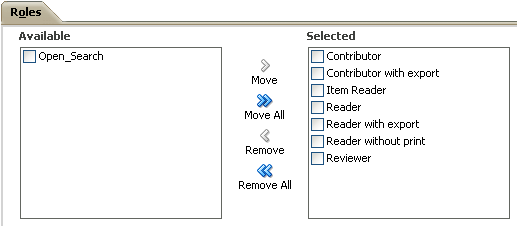
| Element | Description |
|---|---|
| Available | This box lists the roles in this domain that have not been assigned to the current template. Highlight the roles in this box that you want to move to the Selected box. |
| Move, Move All, Remove, Remove All | Use these controls to move roles between the Available and Selected boxes. The Move control and the Remove control will become available only when individual roles have a check mark against them, and will affect only those roles. |
| Selected | This box lists the roles that have been assigned to the current template, or that will be assigned when the Apply button is clicked. The presence or absence of check marks does not have any effect on this. |
| Details | This tabbed area shows all the general, translations, features, and constraints attributes of the role currently highlighted in either the Available box or the Selected box. Role attributes cannot be changed here: domain administrators can change them on the Roles page. |
B.5.3 Context Templates Page: Translations
Use this tab to:
-
Add alternative names and descriptions of the current context template (that is, alternative to the default language).
-
Edit existing names and descriptions.
-
Delete alternative names and descriptions that are no longer required.
Access this tab from the Context Templates page.

| Element | Description |
|---|---|
| New Translation (icon) | Select to open the New Translation dialog, through which names and descriptions can be added for alternative languages.
This is available only if multiple language support has been set up on the Control Console. |
| Edit (icon) | Select to edit the language details currently highlighted in the Translations table. |
| Remove (icon) | Select to remove the language details currently highlighted in the Translations table. A dialog will ask you to confirm the removal. You cannot remove the default language details. |
| Language | This column identifies the language for which the alternative name and description have been provided. |
| Default language (indicator)
|
This indicator against a language name shows that it is the default language. The default language is set on the Control Console. This is the language that is used in locales for which no alternative has been provided. You cannot remove this language from the Translations table. |
| Name | For each language, this column shows the name provided. |
| Description | For each language, this column shows the description provided. |
B.5.4 New Context Template Wizard
Use this wizard to create a new context template. Domain administrators can create context templates.
Open the wizard by clicking the New Context Template icon in the left panel of the Context Templates page.
B.5.4.1 New Context Template: General
Use this page to name and describe a new context template, and to make it available for creating contexts.
This page opens by default as the first page of the New Context Template wizard. It can also be opened by selecting the General node in the wizard header.
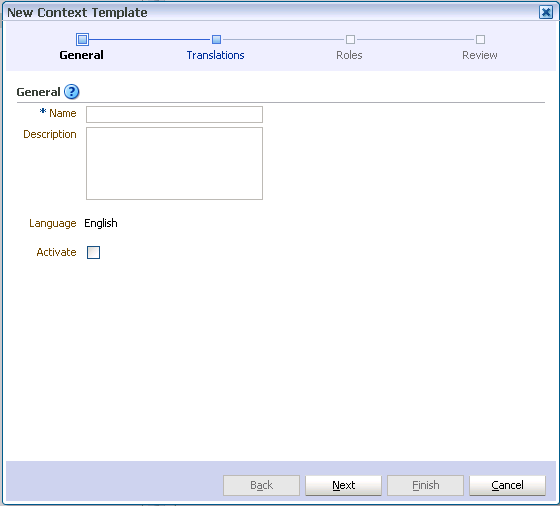
| Element | Description |
|---|---|
| Name
Description |
Enter a name and description for the new template.
The description will be viewable, for example, when creating other Oracle IRM components that are dependent on this one, so a brief but informative description will prove useful. You should enter the name and description in the default language, as shown against Language on this wizard page. The default language was set up on the Control Console, and is the language that is used in locales for which no specific translation has been provided. You will be able to provide names and descriptions in other languages on the Translations page of this wizard, if multiple language support has been set up on the Control Console. |
| Language | Shows which language has been set on the Control Console as the default language. |
| Activate | Check the box to make this template available for the creation of contexts. |
B.5.4.2 New Context Template: Translations
Use this page to provide names and descriptions of the new context template in alternative languages (that is, alternative to the default language).
The name and description that you entered for the default language will already be shown on this page.
This page opens as the second page of the New Context Template wizard. It can also be opened by selecting the Translations node in the wizard header.
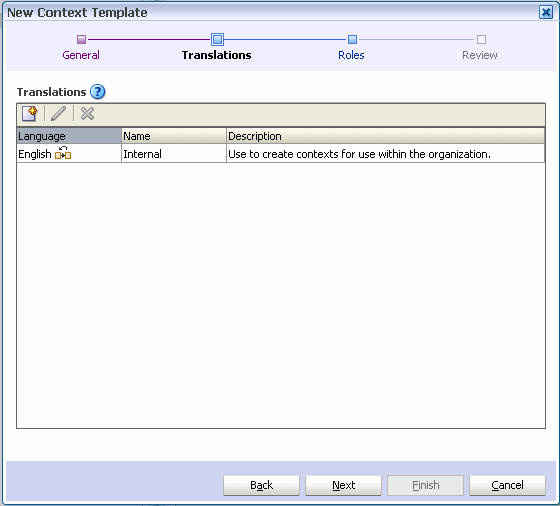
| Element | Description |
|---|---|
| New Translation (icon) | Select to open the New Translation dialog, through which names and descriptions can be added for alternative languages.
This is available only if multiple language support has been set up on the Control Console. |
| Edit (icon) | Select to edit the language details currently highlighted in the Translations table. You cannot change the language associated with an existing name or description. |
| Remove (icon) | Select to remove the language details currently highlighted in the Translations table. A dialog will ask you to confirm the removal. You cannot remove the default language details. |
| Language | This column identifies the languages for which names and descriptions have been provided. |
| Default language (indicator)
|
This indicator against a language name shows that it is the default language. The default language is set on the Control Console. This is the language that is used in locales for which no alternative has been provided. You cannot remove this language from the Translations table. |
| Name | For each language, this column shows the name provided. |
| Description | For each language, this column shows the description provided. |
B.5.4.3 New Context Template: Roles
Use this page to specify which roles will be included on the new template.
This page opens as the third page of the New Context Template wizard. It can also be opened by selecting the Roles node in the wizard header.
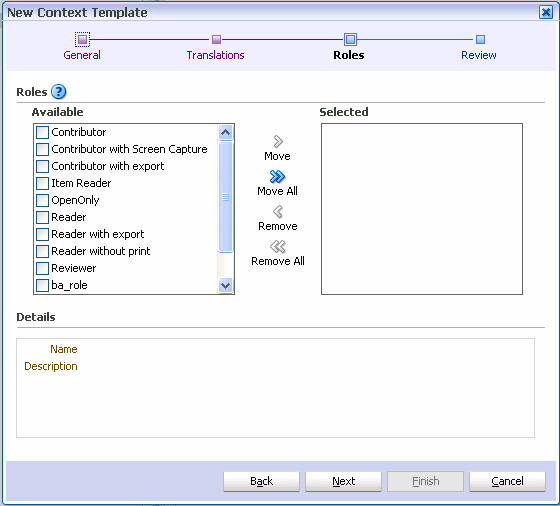
| Element | Description |
|---|---|
| Available | This box lists the roles in this domain that are available for assigning to the current template. Highlight the roles in this box that you want to move to the Selected box. |
| Move, Move All, Remove, Remove All | Use these controls to move roles between the Available box and the Selected box. The Move and Remove controls become active only when individual roles have checkmarks against them, and affect only those roles. |
| Selected | This box lists the roles that will be assigned to the new template when the wizard is completed. The presence or absence of check marks does not have any effect on this. |
| Details | This display area shows the name and description of the role currently highlighted in either the Available box or the Selected box. |
B.5.4.4 New Context Template: Summary
Use this page to review the choices made and information entered on the previous wizard pages.
This page opens as the final page of the New Context Template wizard. It can also be opened by selecting the Review node in the wizard header.
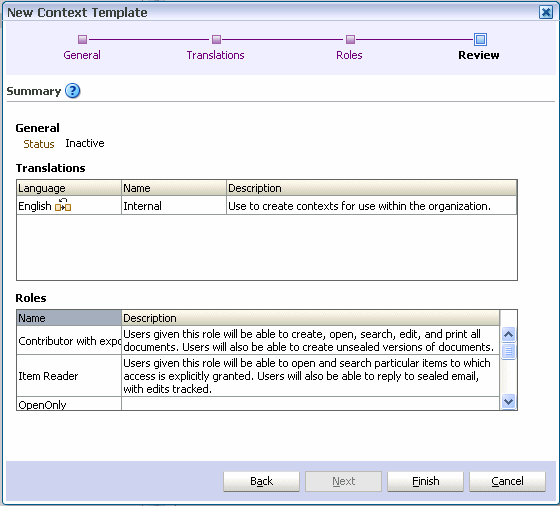
If you are not satisfied with the choices and entries shown on the Summary page, use the Back button to return to the wizard pages and make changes.
If you are satisfied with the choices and entries shown on the Summary page, create the new context template by clicking the Finish button.
B.6 Domain Page
The following pages and dialogs can be used to create administrators:
B.6.1 Domain Page: Administrators
Use this tab to assign users as domain administrators, domain managers, and inspectors.
Note:
You cannot create context managers using this page: context managers are assigned by specifying a user to be the manager of a context (see the Managers tab of the Contexts page).Access this tab from the Domain page.

| Element | Description |
|---|---|
| View | Use this drop-down list to select the types of administrator shown in the table.
All: Select to show inspectors, domain managers, and domain administrators in the table. Inspector: Select to show only inspectors in the table. Domain Manager: Select to show only domain managers in the table. Domain Administrator: Select to show only domain administrators in the table. |
| New Administrator (icon) | Select to open the New Administrator dialog, through which you can create an administrator that will be added to the administrators table.
If you want a user to be more than one administrator type, create multiple entries in the table for the same user. |
| Administrator Details/Properties (icon) | Select to view the details of the administrator currently highlighted in the table. |
| Refresh (icon) | Select to refresh the administrators shown in the table. |
| Remove Administrator (icon) | Select to remove the administrator currently highlighted in the table. You will be asked to confirm the removal. |
| Type, Name, Administrator Type | These columns show the details for each administrator. |
B.6.2 Domain Page: Translations
Use this page to specify the text that will appear in the header of server-specific status pages.
Text in the default language will appear here automatically, because it is taken from text that was entered during server installation.
Access this tab from the Domain page.

| Element | Description |
|---|---|
| New Translation (icon) | Select to open the New Translation dialog, through which names and descriptions can be added for alternative languages.
This is available only if multiple language support has been set up on the Control Console. |
| Edit (icon) | Select to edit the language details currently highlighted in the Translations table. You cannot change the language associated with an existing name or description. |
| Refresh (icon) | Select to refresh the list of translations. |
| Remove (icon) | Select to remove the language details currently highlighted in the Translations table. A dialog will ask you to confirm the removal. You cannot remove the default language details. |
| Language | This column identifies the languages for which names and descriptions have been provided. |
| Default language (indicator)
|
This indicator against a language name shows that it is the default language. The default language is set on the Control Console. This is the language that is used in locales for which no alternative has been provided. You cannot remove this language from the Translations table. |
| Name | For each language, this column shows the name provided. |
| Description | For each language, this column shows the description provided. |
B.6.3 New Administrator Dialog
Use this dialog to create the following types of administrator:
-
domain administrator
-
domain manager
-
inspector
Open the dialog by clicking the New Administrator icon on the Administrators tab of the Domain page.
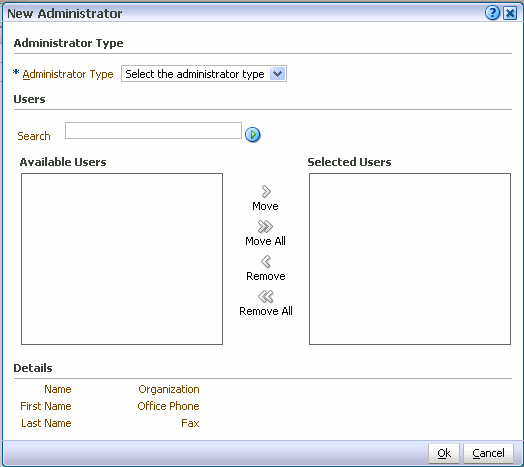
| Element | Description |
|---|---|
| Administrator Type | Use this drop-down list to choose the type of administrator that will be created.
Inspector: Select to specify that an inspector should be created. Domain Manager: Select to specify that a domain manager should be created. Domain Administrator: Select to specify that a domain administrator should be created. |
| Search
Search Users (icon) |
Use this text box and icon to populate the Available Users box with users that are candidates to become administrators. To find known users, type a few letters from the user name into the Search box, then click the Search icon. To find all users, leave the Search box empty, then click the Search icon. |
| Available Users | This box shows users that can be assigned as administrators. If the list is empty, populate it using the Search feature (described above). Highlight the users in this box that you want to move to the Selected Users box. |
| Move, Move All, Remove, Remove All | Use these controls to move user names between the Available Users and Selected Users boxes. The Move control and the Remove control will become available only when individual users have a check mark against them, and will affect only those users. |
| Selected Users | Users whose names are listed in this box will become administrators when the wizard is completed. The presence or absence of check marks does not have any effect on this. |
| Details | This display area shows the details of any user individually selected in the Available Users or Selected Users boxes. |
B.6.4 Administrator Details Dialog
This dialog displays information about the administrator currently highlighted in the Administrators table.
Open the dialog by clicking the Administrator Details icon on the toolbar of the Administrators tab on the Domain page.
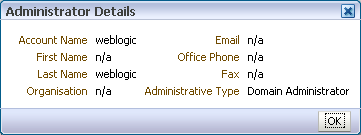
B.7 General Dialogs
The following dialogs are used throughout the product:
B.7.1 New Translation Dialog
Use this dialog to add names and descriptions in alternative languages (that is, alternative to the default language, which was set up in the Control Console).
Open the dialog by clicking the New Translation icon from various locations.
| Element | Description |
|---|---|
| Language | Use this drop-down list to select the language for the alternative text. |
| Name | Use this box to enter a name in the selected language. |
| Description | Use this box to enter a description in the selected language. |
B.7.2 Edit Translation Dialog
Use this dialog to change names and descriptions.
Open the dialog by clicking the Edit Translation icon from various locations.
| Element | Description |
|---|---|
| Language | This display area shows the language for the name and description. This cannot be changed. |
| Name | Use this box to enter a new or amended name in the selected language. |
| Description | Use this box to enter a new or amended description in the selected language. |